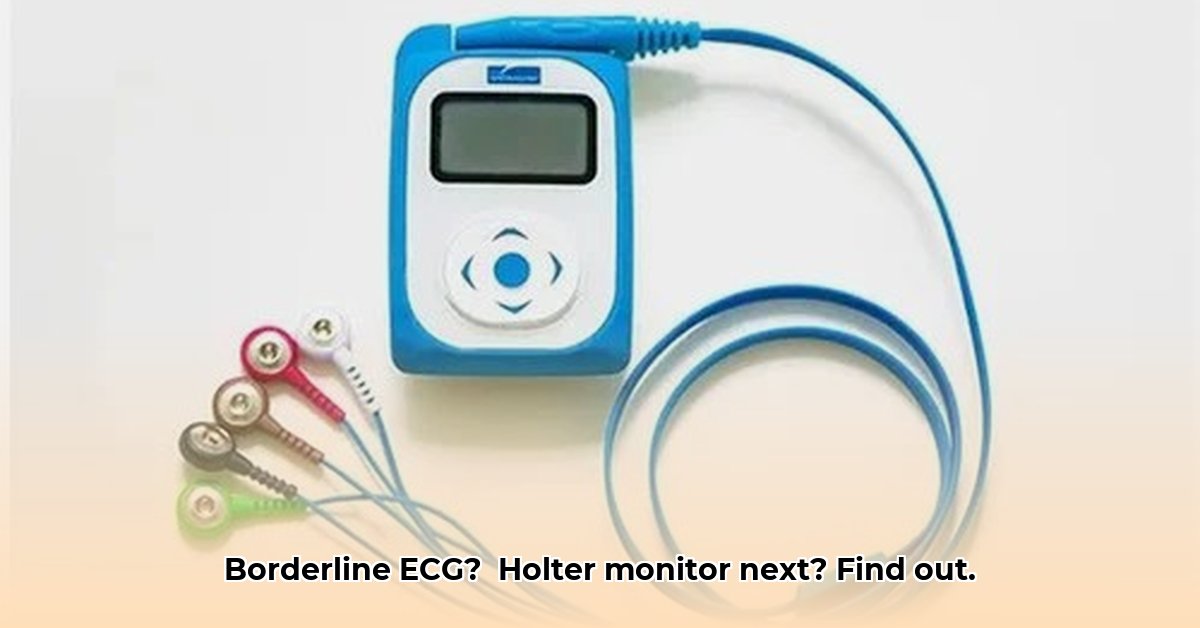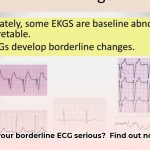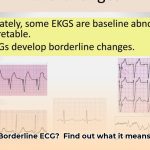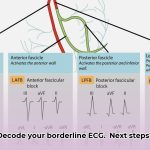Got a “borderline” ECG result? Don’t panic! It simply indicates that your heart’s electrical activity showed some minor irregularities on the initial test. This doesn’t automatically mean a serious problem. It means your doctor wants to investigate further. That’s where a Holter monitor comes in handy – a small device you wear for a day or two. This guide explains what a borderline ECG implies, why a Holter monitor might be needed, potential results, and subsequent steps. It breaks everything down in simple terms for clear understanding and confident progress. You’ll also find tips on heart care and anxiety management.
Holter Monitor After Borderline ECG: Your Comprehensive Guide
A borderline ECG result can be a bit unsettling. It resembles a slightly fuzzy photo where details aren’t perfectly clear. This doesn’t automatically signal a severe heart issue, but your doctor wants a closer look. Here, a Holter monitor becomes essential. This article guides you through the definition of a borderline ECG, reasons for needing a Holter monitor afterward, and expectations from the entire process. Learn about cardiac health, arrhythmia detection, and diagnostic tests.
What’s a Borderline ECG, Anyway? Understanding ECG Interpretation in Detail
An electrocardiogram (ECG) offers a snapshot of your heart’s electrical activity. Think of your ECG as a routine cardiac health check-up. A “borderline” ECG reveals minor irregularities, suggesting something might not be perfectly aligned within normal parameters. These aren’t necessarily major red flags. Often, these minor glitches are temporary and harmless variations in the heart’s electrical signals. However, they prompt your doctor to investigate further for a clearer and more consistent picture of your heart’s rhythm. Common instances involve tiny rhythm variations or slight changes in electrical signal transmission through your heart muscle. These subtleties are hard to confidently interpret from a single ECG recording, hence the need for further investigation and continuous monitoring. A borderline ECG, therefore, is an indication for a more in-depth evaluation rather than a definitive diagnosis.
Understanding the Holter Monitor: Your Heart’s 24/7 Guardian for Continuous Heart Rate Monitoring
Now, enter the Holter monitor. Envision it as a more comprehensive, extended ECG analysis. This small, portable device continuously records your heart’s rhythm for 24 to 48 hours, providing a more detailed and dynamic view of its activity over time. A single ECG resembles a single photograph, capturing a moment in time, while a Holter monitor resembles shooting a short movie of your heart’s electrical activity, capturing its rhythm over an extended period. This extended recording enables doctors to spot patterns and abnormalities that might appear sporadically – fleeting glitches that a single ECG might easily miss. It’s a more thorough and reliable method to examine those borderline ECG findings, aiding in comprehensive cardiac health assessments and enabling a more accurate diagnosis.
Why a Holter Monitor After a Borderline ECG? Identifying Potential Heart Rhythm Abnormalities and Their Triggers
A borderline ECG essentially communicates, “Let’s gather more information to achieve a more definitive conclusion.” The Holter monitor addresses crucial questions your doctor needs answered to ascertain the true nature of the ECG findings:
- Consistency and Frequency: Are those subtle irregularities happening regularly throughout the day and night, or are they just occasional blips related to normal heart rate variability and daily activities?
- Triggers and Correlations: Do they appear under specific circumstances, such as during exercise, periods of increased stress, or while sleeping, potentially influencing heart rhythm and triggering these abnormalities?
- Significance and Clinical Relevance: Are these minor variations truly within a normal range and of no clinical significance, or do they represent something more noteworthy in the context of ECG interpretation that warrants further action?
In brief, the Holter monitor provides a comprehensive and continuous overview, helping determine whether those borderline findings are truly cause for concern or simply normal variations. It adds context, transforming a vague snapshot into a more detailed movie of your heart’s electrical activity, guiding appropriate medical intervention strategies.
What Could Be Causing Those Borderline Results? Exploring the Role of Electrolyte Imbalance, Medications, and Lifestyle Factors
Several factors can lead to those borderline ECG readings. Often, it’s not a serious heart condition at all, but rather the result of temporary or manageable factors. Here are a few potential culprits that can lead to side effects of medication:
- Electrolyte Imbalances: Minerals such as potassium, magnesium, and calcium play a critical and intertwined role in your heart’s electrical function. An imbalance in any of these electrolytes can disrupt the normal heart rhythm.
- Medications and Supplements: Some prescription medications, over-the-counter drugs, and even certain dietary supplements can impact heart rhythm as a side effect, sometimes showing up as borderline ECG results.
- Stress and Anxiety: Elevated levels of stress and anxiety can temporarily and directly affect your heart’s electrical activity, creating those subtle irregularities and potentially leading to borderline ECG readings.
- Lifestyle Choices: Factors such as chronic sleep deprivation or insomnia, excessive caffeine intake from coffee or energy drinks, nicotine use from smoking or vaping, and inconsistent exercise habits can all significantly influence your heart’s rhythm and heart rate.
These are frequently treatable and manageable factors that may resolve the issue once addressed through specific diagnosis and appropriate interventions.
Decoding Your Holter Monitor Results: What Your Doctor Will Look For in Continuous Heart Rate Variability and Arrhythmia Detection
After wearing the monitor for the prescribed duration, your doctor will meticulously analyze the recorded data, searching for patterns and anomalies. They’ll look for patterns in your heart’s rhythm, identifying any significant irregularities, such as arrhythmias (irregular heartbeats), or changes over the monitoring period. This information will be combined with your medical history and physical exam findings to form a complete and holistic picture of your cardiac health. They’ll seek consistent patterns, unusual rhythms, or any other relevant information to establish an accurate diagnosis and initiate an effective treatment plan.
Next Steps: Your Action Plan for Addressing ECG Interpretation and Promoting Heart Health
Following your Holter monitor assessment, here’s what typically happens to ensure a comprehensive and well-informed approach:
Step 1: The Follow-Up Appointment: Schedule a visit with your doctor as soon as possible to discuss the results of your Holter monitor in detail. This is where you’ll get a clear and comprehensive explanation of what the results objectively show and what it subjectively means for your next steps and overall heart health.
Step 2: Possible Additional Tests and Evaluations: Based on the Holter monitor data and your doctor’s clinical judgment, your physician might recommend further tests for a more comprehensive evaluation and to rule out any underlying cardiac issues. These could include:
- Echocardiogram: A non-invasive ultrasound procedure to create detailed images and a moving movie of your heart’s structure and function, assessing overall cardiac function and identifying any structural abnormalities.
- Exercise Stress Test: This test assesses your heart’s response to physical exertion on a treadmill or stationary bike to reveal any problems with blood flow to the heart muscle, checking for ischemia (reduced blood flow) and potential blockages.
- Blood Tests (Electrolytes, Thyroid Function): These blood tests are essential for detecting imbalances in key electrolytes such as potassium and magnesium, which are crucial for maintaining a healthy heart rhythm and managing electrolyte imbalance. Additionally, thyroid function tests can help rule out thyroid-related issues that can affect heart rhythm.
These tests offer a different perspective and deeper insights into your heart’s condition, enhancing the overall picture your doctor has of your heart’s health, as reported by heartmedical.com.
Step 3: Lifestyle Adjustments and Risk Factor Modification: Depending on the results of the Holter monitor and any additional tests, your doctor might advise you to implement some heart-healthy lifestyle modifications to reduce your risk factors, potentially improving heart rate variability and overall cardiac performance.
Heart-Healthy Lifestyle Changes: Small Steps, Big Impact on Sustained Cardiac Function
Even seemingly small changes to your daily routine can significantly improve your heart health, preventing heart rhythm abnormalities and promoting long-term cardiovascular wellness:
- Dietary Modifications: Focus on consuming a balanced diet that’s rich in fruits, vegetables, whole grains, and lean proteins while keeping sodium and saturated fat intake low for improved cardiovascular health and maintaining a healthy weight.
- Regular Physical Activity: Aim for regular physical activity most days of the week – even a moderate amount of daily exercise, such as brisk walking or cycling, will benefit your heart, strengthening cardiac muscles and optimizing heart rate.
- Stress Reduction Techniques: Incorporate stress-reducing techniques into your daily life, such as yoga, meditation, or deep breathing exercises, lowering blood pressure and improving heart rhythm and overall mental well-being.
- Smoking Cessation and Avoiding Tobacco Products: If you smoke or use any tobacco products, quitting is one of the most impactful steps you can take for your heart health, reducing the risk of arrhythmias and improving cardiac health and general well-being.
These modifications can significantly lessen your risk factors and are often beneficial for your overall wellbeing. Aim for continuous improvements for a sustainable approach to cardiovascular fitness.
Addressing the Anxiety and Concerns: It’s Okay to Feel Concerned – Proactive Strategies for Managing Emotions
Receiving a borderline ECG reading can understandably trigger feelings of concern and anxiety about the unknown. It’s natural to feel anxious, but remember that many borderline ECG results are totally benign and don’t indicate serious heart problems. However, open and honest communication with your physician is crucial to dispel any uncertainty and address your concerns directly. Your doctor is there to guide you through this process and alleviate any anxieties associated with ECG interpretation. Don’t hesitate to express
- Wellness Fair Ideas for Work to Boost Employee Wellbeing - December 15, 2025
- Affordable Employee Wellness Fair Ideas for Any Budget - December 14, 2025
- Employee Wellness Programs Strategically Benefit Employee Health And Retention - December 13, 2025
















